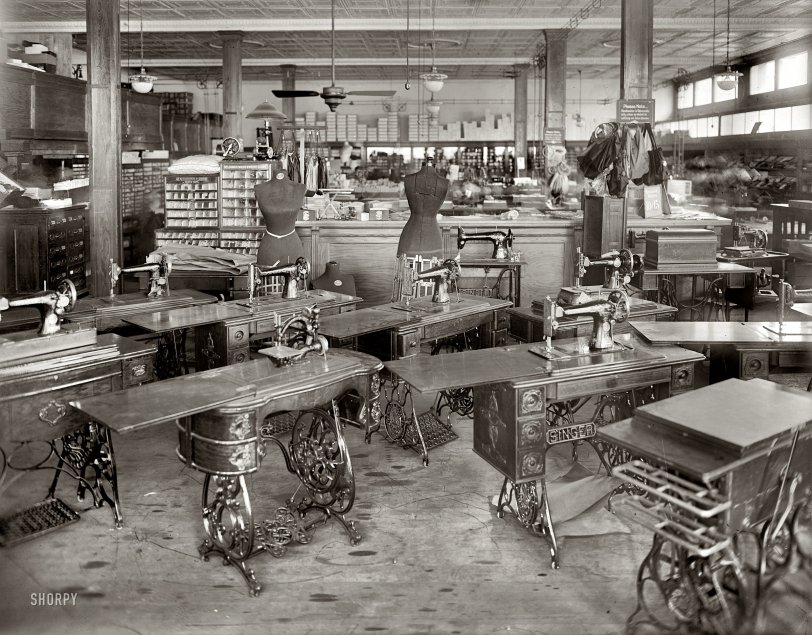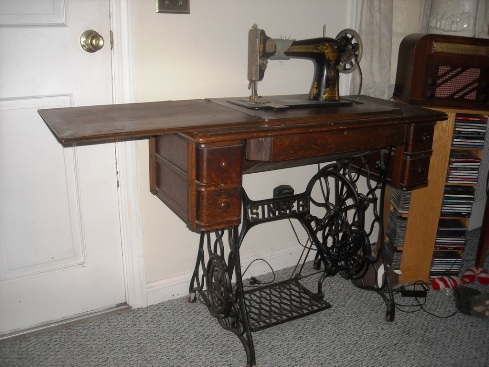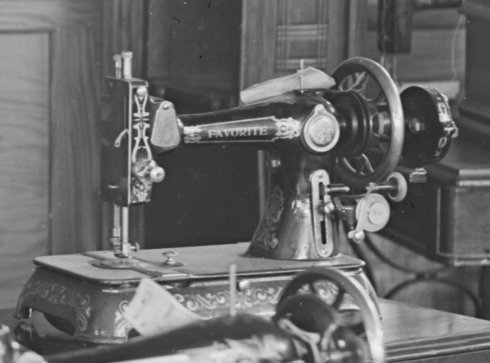


Framed or unframed, desk size to sofa size, printed by us in Arizona and Alabama since 2007. Explore now.
Shorpy is funded by you. Patreon contributors get an ad-free experience.
Learn more.

- Freeze Frame
- Texas Flyer wanted
- Just a Year Too Soon
- WWII -- Replacing men with women at the railroad crossing.
- Yes, Icing
- You kids drive me nuts!
- NOT An Easy Job
- I wonder
- Just add window boxes
- Icing Platform?
- Indiana Harbor Belt abides
- Freezing haze
- Corrections (for those who care)
- C&NW at Nelson
- Fallen Flags
- A dangerous job made worse
- Water Stop
- Passenger trains have right of way over freights?
- Coal
- Never ceases to amaze me.
- Still chuggin' (in model form)
- Great shot
- Westerly Breeze
- For the men, a trapeze
- Tickled
- Sense of loneliness ...
- 2 cents
- Charm City
- What an Outrage
- Brighton Park
Print Emporium
Little Shop of Singers: 1919

Washington, D.C., circa 1919. "Oppenheimer's dress shop." Haunted by a few spectral customers. National Photo Company glass negative. View full size.
Terrific machine
My mother had a degree in Home Economics and was an expert seamstress. She used to say that the best sewing machine she ever owned was her Singer, which was very similar to the ones shown here. And that included all the computer-driven models she also owned. The Singer was a brilliantly created machine - very responsive and easy to use. Some basic designs cannot be improved upon. Well, okay, maybe a little, but not much.
Hey! There's my Singer!
Right smack dab in the middle of the 1919 photo. Actually it was my grandmother's and handed down to me. You can't imagine the fun we bunch of urchins had pedaling that thing circa 1969.

Hand cranks
The Favorite and Ideal machines are hand cranked.
The machine to the right of the center mannequin is Singer Model 31-15 for light industrial use. Many of them are still in use today (usually electrified); they're known as 'the tailor's machine'.
Still In Use
My father rebuilt my grandmother's Singer machine approximately 15 years ago. On a whim he went to the local sewing shop that was a Singer dealer looking for a replacement leather belt. To his surprise Singer still supplied the leather belts and a few other parts for these old machines. The reason was that many were still in use in locations with no electricity and in third world countries.
IDEAL FAVORITE Sewing Machines
Two brands which appear to be electric models.


The Old Man and the Spool
On the shorter cabinet behind the dress dummy on the left can be seen “M. Heminway & Sons Co.” General Merrit Heminway was the first person to wind silk on a spool in the U.S. and, in 1849, began the manufacture of “sewing silks of all kinds” according to the Web site History of Litchfield County (Connecticut). From the mid-1800s through 1917, his company (formerly Bishop & Heminway) was called M. Heminway & Sons Silk Company. He was long gone when this photo was taken unless he made it to age 119. To the right we see “Beldings Wash Emb’dy (embroidery but you knew that) Silks” which would have come from Belding, Michigan, called the “Silk City” because of all the silk mills there.
My mother had a Singer machine very much like those in the photo, most probably used before her by her mom and perhaps her mom’s mom. It had rounded drawers like the one in the foreground. I remember its shiny black finish and gold leaf decoration, and the clever way the machine could be rotated 180 degrees to disappear into the cabinet, with the hinged panel on the left flipped over to create a small desk. Most of the machines here have the same set-up. It just occurred to me that a similar arrangement could be designed for computer monitors. I'd name it "SmartDesk".
(The next day) A revisit to "Little Shop of Singers" and looking at all that sewing machine furniture inspires an alternate title: "Little Shop of Drawers".
Willcox and Gibbs
The little machine in the left foreground is a Willcox and Gibbs chain stitch machine which was a major competitor of the Singer Co.
It was manufactured with very little change from the middle 1860's to sometime in the 1960's I think.
Electrification of most of the older machines was available
a moderate cost and became popular as electrical power reached the rural areas.
Nice picture!
Cabinets
In 1868, the New York based Singer Brothers Company decided to locate the Singer Cabinet Works in South Bend, Indiana (my hometown). The area contained a rich supply of fine walnut and oak lumber with which Singer would build cabinets for their sewing machines. By 1907, 10,000 cabinets a day were produced in South Bend, and by 1914 the company had gained 75% of the world’s market of sewing machine cabinets. The company remained in South Bend until 1955. Lewis Hine (no surprise) took some photos of child laborers outside the plant in the early part of the century.
Hooterville Telephone Company
Looks like Oliver Wendell Douglas isn't the only one that had to climb before making a call. Between pedaling the machines and ascending to the phone, I imagine the shopkeeper kept rather fit.
No cash registers
In the background we can see the pulleys and cables that were part of a cash handling system long gone from our midst. The clerks would write up the sale, and send the ticket with the cash in a little wooden barrel, zipping along the cables, to the clerk's office (I think that's it at the left, note the candlestick telephone up near the ceiling). The little canister or barrel would get sent back to the clerk with the Paid receipt and any change in it. As a kid in Upstate NY, I'd be entranced by watching this system in operation at a local dry goods store. Part of this system is still in place as a piece of historic technology, but the rest was supposedly packed off to the Smithsonian some years ago.
Insight
Great photograph. It's neat to see all of the original displays, forms and sewing machines. Ironically, I love taking the iron bases and making new tables out of them. Oh, to have all of those models in hand! Thanks for posting this.
Hello, Ghost?
All of the machines appear to be approximately the same with slight variations in their support tables. Some have one style drawer handle, others have a different one. But the machine at the front left is of an entirely different era or manufacturer. I wonder if that is a used machine somebody traded in when they bought a new Singer.
There is also a telephone sitting on top of all the cabinets on the far left. I am guessing that is a guest phone for the ghosts because I can't imagine anyone else being up there to answer it.
Old Sew and Sews
I'm betting these machines were on their way out to make way for the latest electrically powered models.
























On Shorpy:
Today’s Top 5